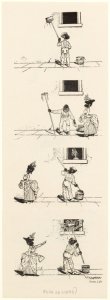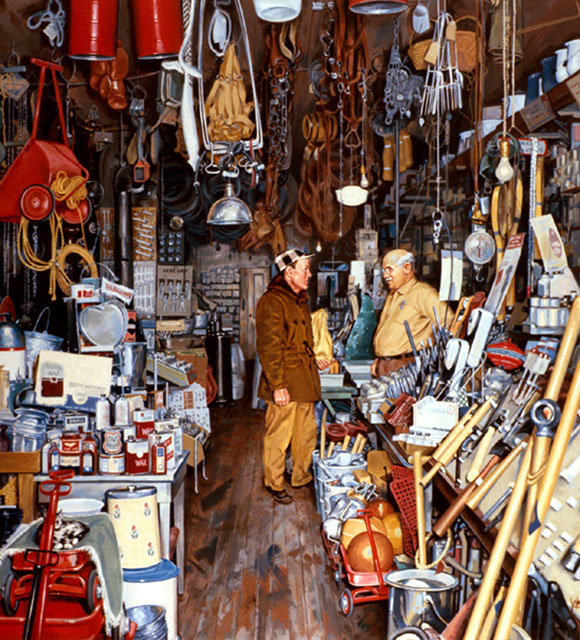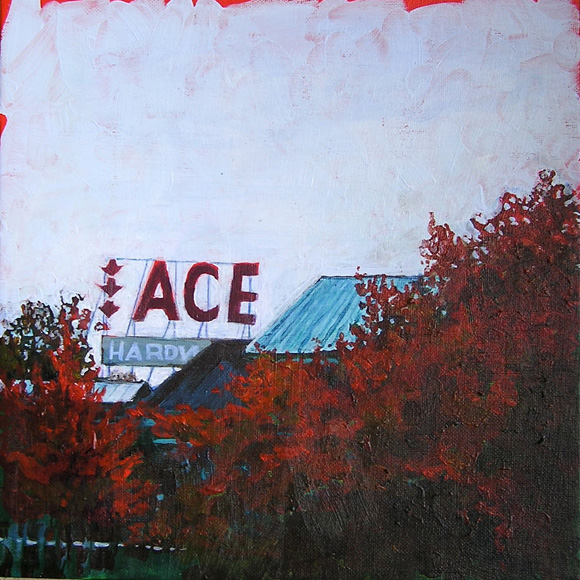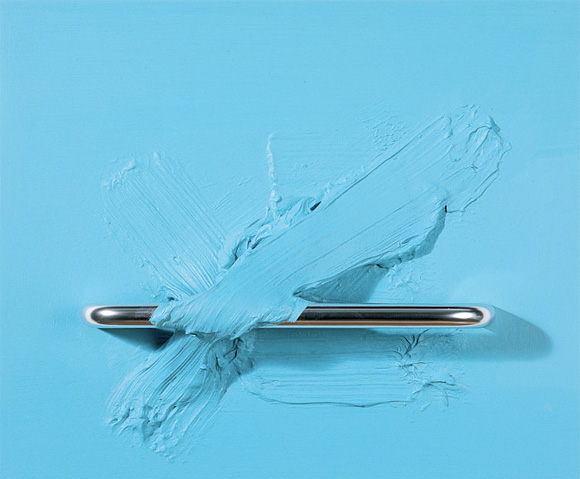hardware literature
art fiction film music television history language poetry stores tools hardware catalog jmcvey.net
overhaul now in progress (29 June 2023)
- Russ Johnson. Forty Years with Mister Oswald (1968)
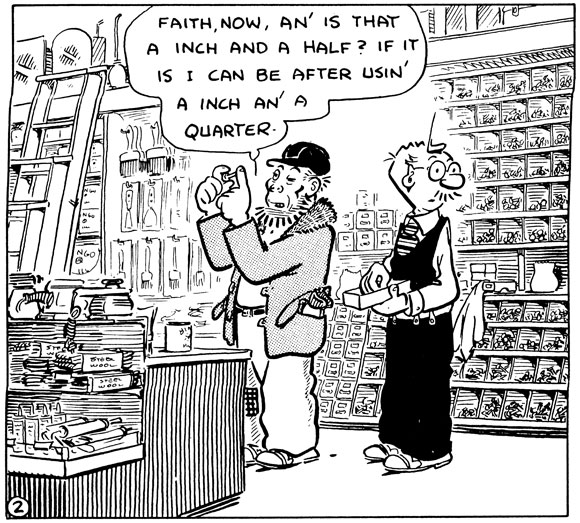
Image from page 241 of this book. While Jerry contemplates bolt length, Oswald eyes the Van Boodles, a wealthy couple (Mr Van Boodle is owner of the beet sugar works) who are looking over color television sets... (shown here without permission, for now).
Mister Oswald ran for many years in the trade magazine Hardware Retailer. Rob Stolzer’s illustrated interview with Russ Johnson can be found at Hogan’s Alley : online magazine of cartooon arts. See also Stolzer’s fine Russ Johnson gallery page.

- Charles Austin Bates (1866-1936), editor. The Hardware Book (New York: The Charles Austin Bates Syndicate, 1899). The Open Library page for this book provides access to pdf, the Internet Archive page, and to LC metadata.
Purchase of (subscription to) the book entitled one to other services, including (1) a letter of criticism and advice; (2) a plan for changing from credit to cash; (3) subscription to Good Advertising for one year; (4) a book of store rules
such as are used by leading houses
; (5) subscription to The Show Window for three months; (6) 225 coupons, eachentitling the holder to purchase one single, or half-column, wood-base cut at sixteen (16) cents and postage.
Pages 3-19 are introductory (bromides, discussion of importance of advertising); followed by
Ready-Made Ads for Busy Merchants
(148 recto pages, all but the last six of which show one cut and accompanying copy per page); followed byCatch-Lines and Headings, clipped from various sources
(13 recto pages); followed byRecord of Advertising Contracts
(8 recto pages); followed byDaily Sales and Advertising Record
(13 recto pages).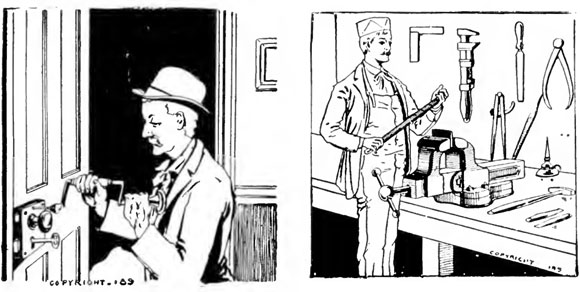
Cuts No. 3272 (
Good tools...
) and 5702 (The practical mechanic...
), ex The Hardware Book (1899)Bates’s business was prolific, and warrants further investigation. It was a so-called
non-placing
agency in that it generated copy and art, but did not place the ads (which ultimately wasn’t an efficient model for advertisers). (See Yerodin Sekou Bermiss, The Emergence and Evolution of Professional Service Industries (Northwestern University dissertation, 2009), p70). Ad Age provides a paragraph-length bio here.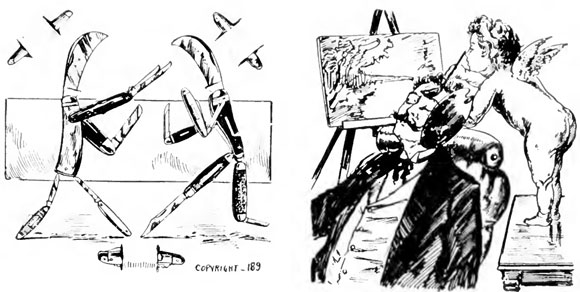
Cuts No. 3263 (
Our assorment of knives...
) and 3207 (It is a little out of the regular order of things, perhaps, but we have a big supply of paints and artists’ materials...
), ex The Hardware Book (1899)The Bates art brings to mind R. F. Outcault, specifically his
Ad cuts for hardware and sporting goods
(copyrighted 1914), listed (though alas not illustrated) here.

- silk bookmark, Egyptian letters and lag bolt thread design

bookmark, 11.25 x 2 inches, The Boettcher Hardware Co., Denver, Colorado.
printed by A. Gast & Co., St. Louis & N.Y.Boettcher Hardware Company was founded in 1884 by German immigrant and Colorado entrepreneur Charles Boettcher. The new firm was not Boettcher’s first hardware business — he had operated others in various mining settlements. In this case, he purchased an existing wholesale hardware business, and moved it to 402 Lawrence Street in January 1885. (Geraldine B. Bean, Charles Boettcher: A Study in Pioneer Western Enterprise (Boulder, Colorado: Westview, 1976): 92.
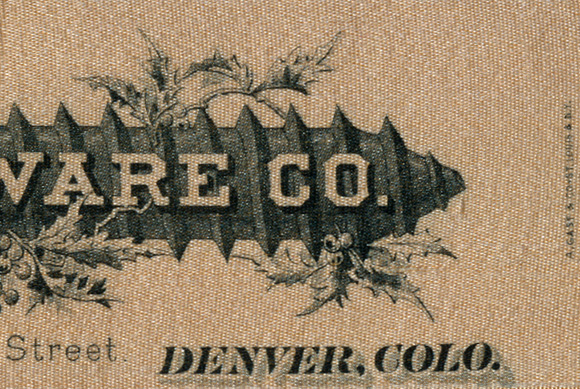
bookmark, detail, The Boettcher Hardware Co., Denver, Colorado.
A. Gast & Co. was a printer of checks and banknotes. The printing was apparently from stone, possibly via transfer from an etching. The offsets under
Denver, Colo.
andSeason
appear to be intentional.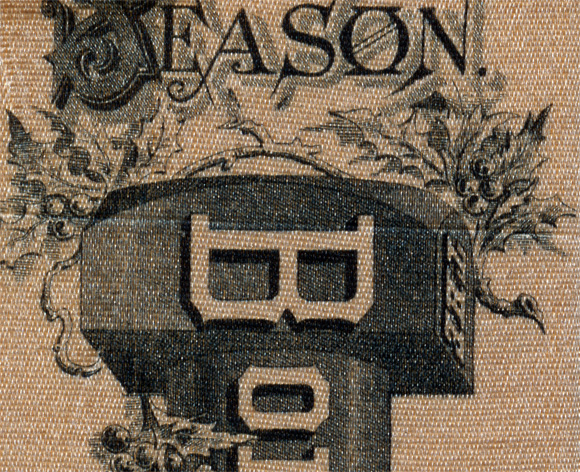
bookmark, detail, The Boettcher Hardware Co., Denver, Colorado.
Thanks to Robin Bledsoe, Bookseller (specializing in horses) for this find! And to David Whitesell and Lauren Hewes at the American Antiquarian Society (Worcester, Mass.), and to Alastair Johnston and Frances Butler for their advice re: the printing.

- Namu amidabutsu rokuji myōgō (banjō) : namuamidabutsu
[南無阿弥陀仏六字名号(番匠)] 南無阿弥陀仏.
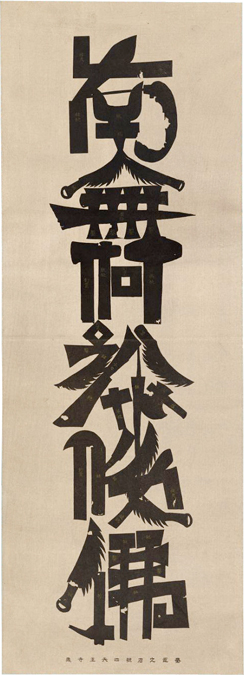
Image (minus scroll) from item in Petzold Collection, Box 28, Harvard-Yenching Library, Harvard University
Harvard University, Harvard College Library Harvard-Yenching Library, 012792522
permalink.The characters expressing a Buddhist prayer are formed from representations of carpenters’ tools.
Title from
Hābādo Daigaku Yenchen Toshokan shozō Burūno Petsōrudo kyūzō shiryō (jikusō, kansusō) mokuroku = Catalog of scrolls in the Bruno Petzold Collection preserved at the Harvard-Yenching Library
published by Nichirenshū, edited by Prof. Annaka Naofumi and Sasaoka Naomi, 2011.Lettering associated with tools and hardware stores, including signs, deserves its own special section (and book).

- Cole Hardware (San Francisco) windows

Taken from Cole Hardware’s posterous page, and shown here with kind permission from Cole.
The goal is to make our windows 99% hardware. Everything in the windows, including backdrop, flooring, trim and display units is from the store. Curtains are made from drop cloths and wall coverings from asphalt paper.
Juliana Brodsky shows Cole’s Halloween window (October 2011) — entire and details — here, and makes the connection to the board game
Clue.
Book-related details from her presentation are shown below.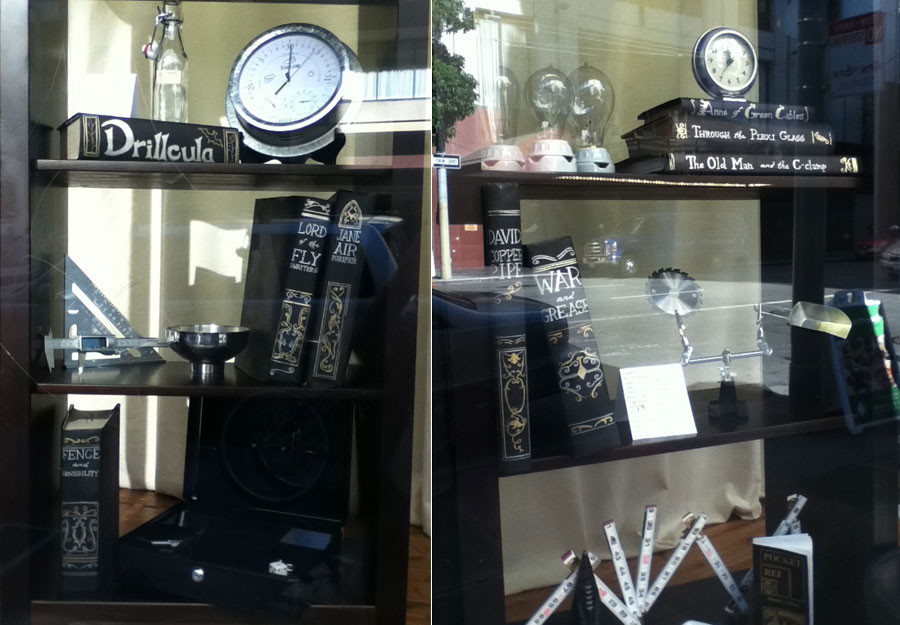
These images shown courtesy of Juliana Brodsky, her blog Old Green & Awesome (posted 24 October 2011)
I show the book covers, from Noell’s Halloween windows at Cole Hardware, because they connect with the overall theme of these pages — hardware store literature. There is more to be seen both at Brodsky’s blog, and at Cole Hardware’s own windows page at posterous.
Will be sure to visit Cole on my next trip west. More about the
Curator of All Things Hardware
here (SFGate/Chronicle, November 30, 2009).
- Sandra D. Crandall, cover art.

cover, BYTE Magazine Vol. 2, No. 2 (March 1977), illustration by Sandra D. Crandall.
About the cover —
This month’s cover is by Sandra D. Crandall, Narragansett, RI... When she painted her updatedAmerican Gothic,
she was completing her BFA in Art at the University of Rhode Island, and as assistant Art Department slide curator, maintained a library of over 40,000 slides.My fiance is finishing his BS in Computer Science and is an avid BYTE subscriber from the word go,
she said.No luck in tracking the artist down, to ask for permission to show here.

- Crest Hardware Art Show
Crest Hardware in Williamsburg, Brooklyn makes room, amongst its mundane inventory, for an exhibit of tool-related art that in summer 2009 observed its eighth year.Read about it here (The New York Times, 6 July 2008).
Also —
Crest Hardware Artshow 2011
Crest Fest ’10
Crest Hardware Art Show ’09 (Flickr set by Collin Mel)
Crest Hardware Art Show ’08 (Flickr set by Collin Mel)
and
interview with Joseph Franquinha, Crest Hardware (Gothamist Blog).
- Walker Evans.
Beauties of the Common Tool : A portfolio by Walker Evans.
In Fortune (July 1955)
Described, and some scanned pages, here.I don’t know much about Evans’s career or oeuvre, but apparently his work in the 1950s is considered to have been a decline from earlier achievement. James Guimond, in his American Photography and the American Dream, quotes this handwritten note by Evans himself :
Time and again a man will stand before a hardware store window surveying the tools arrayed behind the glass; his mouth will water; he will go in and hand over $2.65 for a perfectly beautiful special kind of polished wrench; and probably he will never, never use it for anything.
(University of North Carolina Press, 1991)We’ve seen that notion of eyeing and purchasing tools that will never be used, elsewhere in the literature, e.g., Phyllis McGinley her
Please Lock the Hardware Store, or The Temptations of Oliver James
(here).
- The Tool as Object, the catalog of an exhibit of Anglo-American Hand Tools at the Craft and Folk Art Museum, Los Angeles (1976)
158 items described in the catalog of representative tools; 26 tools shown in halftone photographs by Donald A Hall. Edward F. Tuttle curated, and wrote the smart three-page introduction, in which utility and the
extra-functional formal qualities of tools
are addressed.Precisely because tools are so dominated by their intended function, one’s attention tends to be drawn immediately to this aspect, and their other qualities risk passing unnoticed or little heeded... [Formal features] are always abstract relative to the
narrative
in tools...
- Berta and Elmer Hader. Little Town. New York: The Macmillan Company, (October) 1941
An illustrated day-in-the-life look at
Little Town,
fromOne o’clock and all’s well
to midnightand all’s well in Little Town.
Lovely, detailed illustrations evenly balanced (space-wise) by text, throughout.
page 46, Berta and Elmer Hader, Little Town (1941)
“Mrs. Dee and the children stop in at the hardware store. Drawers of screws, bins of nails, bolts, lugs and hinges. Tin pans and copper kettles, pots of iron or brass. Hammers, saws, bits and braces, chisels and planes to work with. Seeds for your lawn and seeds for the garden. Mrs. Dee buys a package of marigold seeds. Dotty chooses nasturtiums.” (p46)
Arrangement of merchandise is haphazard — saws above seeds; chisels, planes and pliers next to pots and kettles, and above garden hoses — but suits the music of the prose. There’s a mix of line drawing, inking and stippling throughout, along with several color illustrations.
This is a wonderful volume. One bookdealer’s description says it portrays Nyack, New York (maybe from evidence on dust jacket, or because the Haders lived nearby?). Details of many shop and other interiors, street scenes, etc. The interior of the
Ten Cent Store
shows a black woman and her son, among other customers (but not at the lunch counter). Some scenes that one might expect to find, are missing — a school room, the interior of a church — but not missed! A minor note is quietly struck by mention of “old Captain Tom, who had piloted the ferry across the river for more than fifty years. The bells toll softly for him in the little chapel over the hill.”Berta and Elmer Hader were prolific (illustrating 70 books, of which they wrote about half, according to wikipedia). Indeed, a fascinating pair, the subject of the Hader Collection (opens to their links page), and a biography under way by Sybilla A. Cook, provisionally entitled Drawn Together.
Great illustrations, because there’s so much to look at in them, so much to see.

- Pete Hamill. Tools as Art : The Hechinger Collection. New York: Henry N. Abrams, 1995
link at Pete Hamill’s website
- Hechinger Company. Annual Report, Year ended January 28, 1989
feature section : Tools As Art / The Hechinger Collection“The graphics of this year’s report focus on the personal art collection of John W. Hechinger, Jr.” The report features images from then-upcoming Tools As Art exhibition at The National Building Museum, curated by Carolyn Laray, and includes an essay by Jane Livingston. See also the entry for Pete Hamill, Tools As Art : The Hechinger Collection (1995)

- F. M. Howarth.
Weary Willy’s Attractiveness,
in Puck (1899)
panel 3 (of 9),
Weary Willy’s Attractiveness,
by F. M. Howarth, in Puck vol. XLV. No. 1154 (April 19, 1899), pp4-5The full nine panels, rearranged for this page, are shown below at a smaller size.
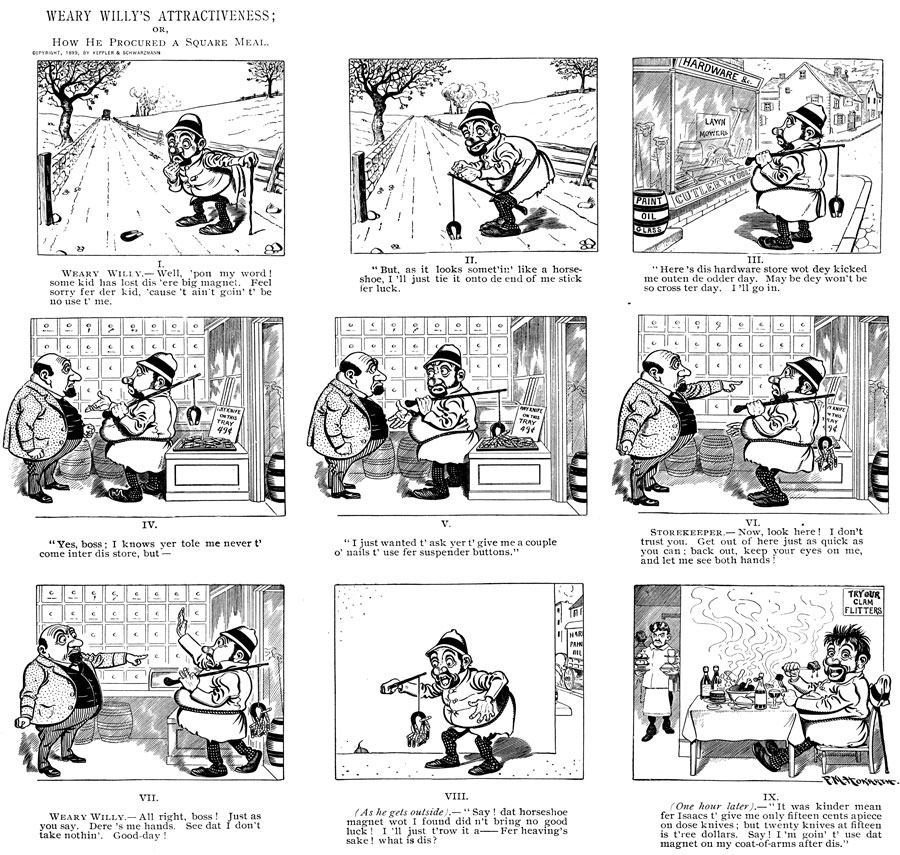
cartoon by F. M. Howarth, appeared in Puck vol. XLV. No. 1154 (April 19, 1899), pp4-5
Franklin Morris Howarth (1864?-1908). A self-portrait, and a word on his
method
can be found here. The NYPL Digital Library gallery shows 43 items for Howarth (as of 4 May 2011), including his book Funny Folks (1899).Some other material can be found at Andy’s Early Comics Archive. This work and, for example, Howarth’s Man washing a building distracted by a woman on the street (1893) —
— reminds me of the physical humor of Buster Keaton (who, I might add, was a fan of hardware stores).
Maria Dering maintains a blog entitled F. M. Howarth : A Life in Pictures, and has also written an interesting story about Howarth at Urban Scrapbook (in five parts, posted March through June 2009).

- Alice Hutchins (1916-2009). Magnetic works.
Uses materials obtainable from hardware stores, and magnets, to create re-configurable art. Associated with Fluxus. More here and here, where we read about Hutchins’s association withhardware store culture.

- Hardware Sculpture (Complete Instructions and Full Size Patterns for : Airplane, Antique Coupè, Antique Roadster, Locomotive & Space Module)
Creative American Craft Series by Hazel’s guest artists.
HA-59. City of Industry (California) : Hazel Pearson Handicrafts, 1977.Editorial and Layout
by Irene Zachario, Lynette Eastland and Stephen Van Handel.Hardware sculpture is one of the most unique of the popular crafts! Composed of a wide range of materials, not usually associated with art objects, these sculptures utilize nuts, bolts, screws and nails; things you might use to build a wall, but never hang on a wall! Here we present 5 projects to keep you visiting your workshop, but not to work in it.

- Inax. 職人のミクロコスモス ── 仕事場と道具 / Shokunin no mikurokosumosu (The Microworld of the Craftsman : Workplace and Tools), published by the Japanese sanitaryware maker Inax in 1985.
Not about hardware retailing, but tools. Photographs of tools in situ, showing signs of years of use (in some cases) and the close spaces in which their users attend to their craft, day after day, are quite beautiful.
The exhibit was curated by Okamoto Shigeo. Essays (rough translation of their titles) and authors : Endo Motoo, “The Craftman’s mentality, today and yesterday;” Yasuda Takeshi, “Craftsmen I’ve known;” Naito Masatoshi, “Tea ceremony chasen;” Endo Toshikatsu, “Wood carvers in Takayama;” Rokaku Kiji, “Workplace of lacquer artist;” Murota Takeshi, “Post petroleum;” Tagi Koji, “The body as tool.”
Inax (Lixil, publication page)

- Carol Johnson, a painting of the interior of Wolgast Hardware, in Alta Vista (Wabaunshee County), Kansas (1955). Collections of the Kansas Historical Society, Topeka
Shown above (with permission) and described here.
Wolgast Hardware was in business from the 1920s until 1970.
- Ariell Jones, tools, cloth, thread
Work done for sculpture class, Montserrat College of Art, Fall 2010. Shown with permission of artist.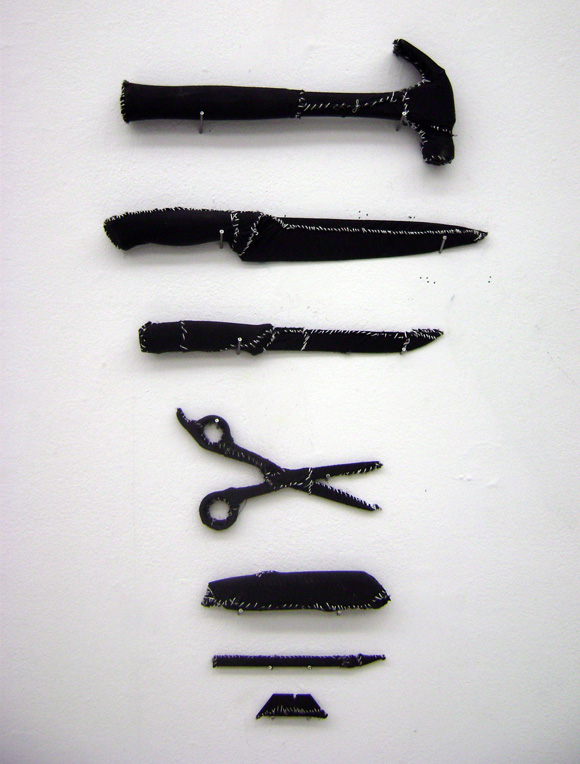
Artist’s blog here.

- Jim Neidhardt, Nuts & Bolts : Fifteen Clues to Life (2015)
images from the book, and other of the artist’s work, via Augen Gallery (Portland, Oregon) : link
artist’s website : link (opens to page with a brief profile)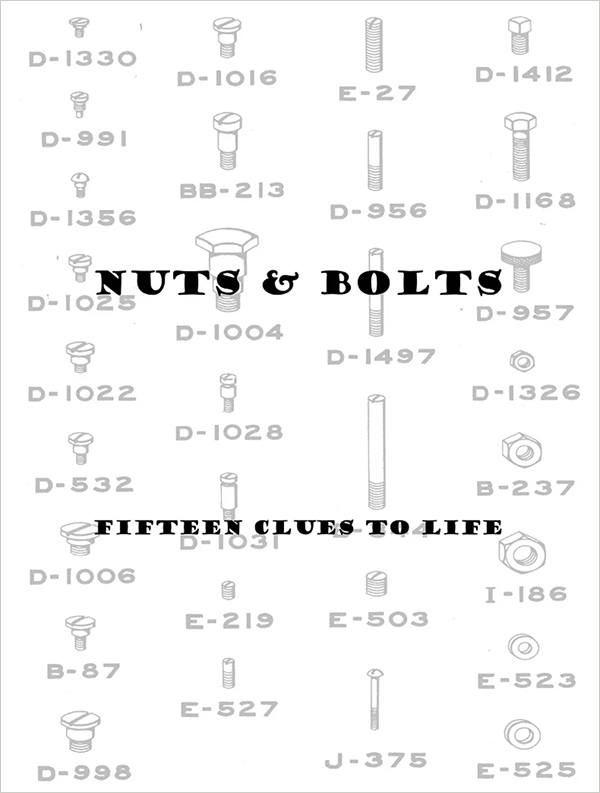
image from artist’s website, publications

- Catherine Opie, hardware store interior
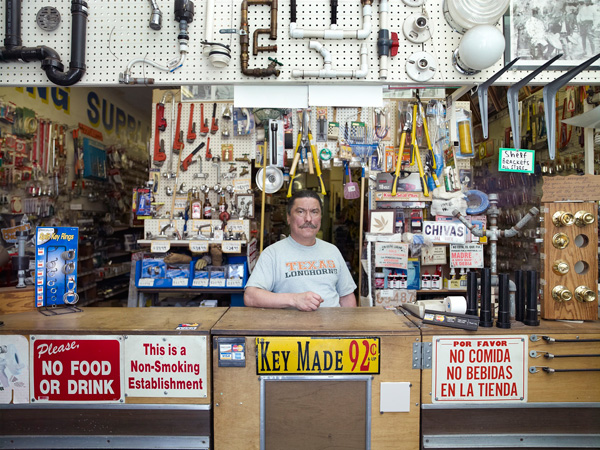
Catherine Opie,
Bravo,
2011. 15 x 20 inches. Inkjet print. Shown here courtesy of the artist (via CCA Wattis Institute for Contemporary Arts)There’s a lot in the photograph — consider buying one (Chromogenic print, Unframed 11 x 17 in.) in support of CCA here — in order to examine its details more closely. I’m drawn to the altar at the right of the counter, and the prayer atop the display of doorlocks and deadbolts, a couple of which have been removed, presumably to be sold. Hardware stores sometimes (always?) have little micro zones or climates, areas with their own little genus loci. It might involve the precision tools and measuring intruments (calipers, say); or boxes of files, or a photo of the old days, or a few avocados brought in by a friendly customer. This photograph captures that.
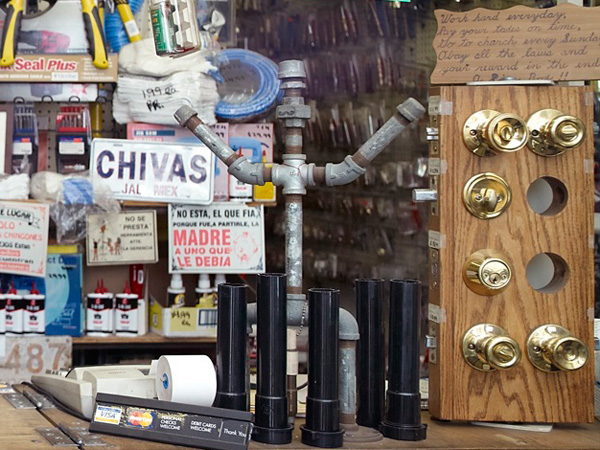
detail, Catherine Opie,
Bravo,
2011. 15 x 20 inches. Inkjet print. Courtesy the artist (via CCA Wattis Institute for Contemporary Arts)I don’t know what the series or context is for
Bravo,
although it relates at least somewhat with Opie’s photographs of Los Angeles minimalls. Similarly loving photographs, of shops and their proprietors/clerks, can be seen in Max Galli, Vom Charme der alten Warenwelt (1992), described here.Much more here, at Opie’s Regen Projects page. My first encounter with Opie’s work was her images of freeways; her range (and depth) are amazing. More can be seen at the Stephen Friedman Gallery.
A somewhat larger version of the above can be seen at eventseekr (Art Top 5 in the SF Bay Area, Fall 2011).

- Damián Ortega.
The Controller of the Universe
(2008)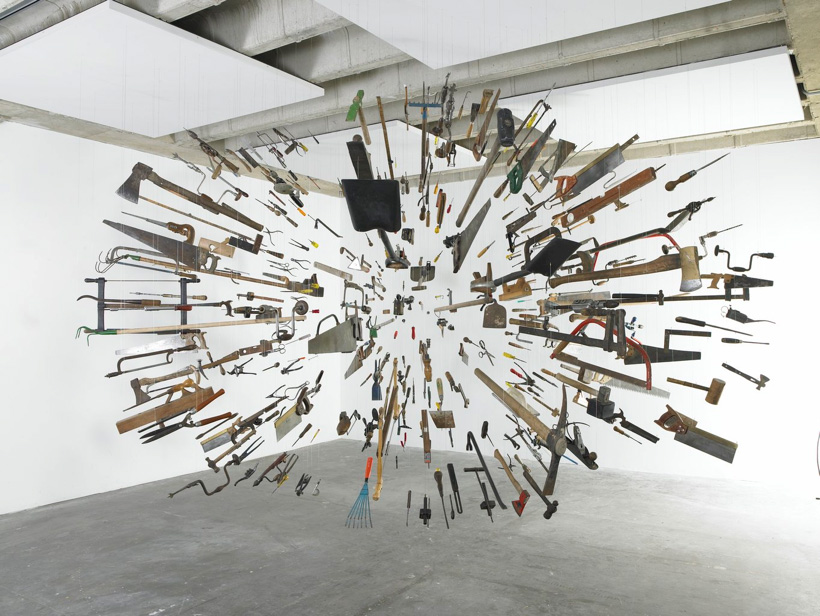
Damián Ortega,
Controller of the Universe (detail), 2007.
112 3/16 x 159 7/16 x 179 1/8 in. (285 x 405 x 455 cm) Found tools and wire
(artist’s page, at White Cube, here).See Laura Quintrell’s review/essay on an Ortega show —
Everyday Design at the Cleveland Museum of Art,
at Unmaking Things 2012-13 (here). Unmaking Things is a vehicle for the writing of students in the History of Design MA program at the RCA and V&A Museum. The Cleveland show — The Blast and Other Embers — runs through September 29, 2013
- Paul Henry’s Art Gallery
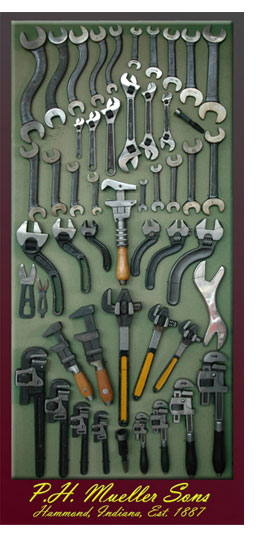
This business has morphed mainly into an art gallery, with a small stock of hardware for the neighborhood, as well (apparently) as a key machine. Owner David J. Mueller writes —
I am the fourth-generation owner/operator of a Hammond, Indiana hardware store, P.H. Mueller Sons. The store was founded in 1887 by my great-grandfather, Paul Henry Mueller (P.H.)... The company has also been involved in other business sectors on-site, including sheet metal work until 1939 and automotive paint from 1940 until 2006... We opened our latest associated feature, Paul Henry’s Art Gallery and Studios in the space recently occupied by the paint store.
The business is described thus —
We are a full spectrum art gallery occupying 7000 square feet of floor in our vintage building. Three seperate and distinctive spaces offer versatile viewing of the art on exhibit. Over 150 artists are represented in a wide range of form, style and media. We host a number of activities including association and club meetings, art classes and exhibit openings, live music and fundraising events.
So here is a lovely example of the multiple genres occupied by
the
hardware store. The owner’s facebook page offers info about shows, and what I can only describe ashardware store humor
on its wall; thewall photos album
includes some views of vintage tool displays,unchanged since their assembly and arrangement in 1922,
as well as photos of events, art, musicians — all the sorts of things that go on there.Shown above is of one of the carefully arranged tool displays in the store. It is available as a poster, in several sizes, via P. H. Mueller Sons here.
links —
Paul Henry’s Art Gallery
owner David J. Mueller’s facebook page (announces events), and
recent (May 17, 2011) profile at Apartment Therapy Chicago.
- Kelly Reemtsen.
Oh! Is for Orange.
(2010? 2011?)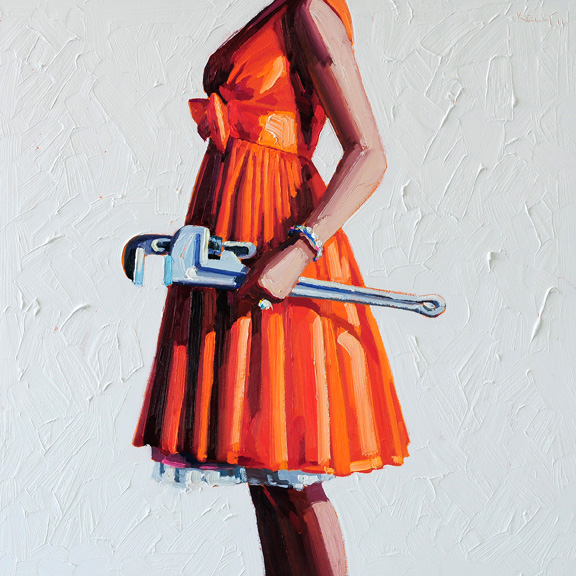
Oh! Is for Orange.
oil on panel, 36 x 36 inches. Shown with gracious permission of the artist.This is interesting work, and I suggest a look at the artist’s website here. See also the nice presentation at Skidmore Contemporary Art, where a smart essay on Reemtsen’s work (by Lia Skidmore) can also be found.
The paintings feature women in dresses — shirtdresses, party dresses — hard to pinpoint the decade, some amalgam of June Cleaver and Mad Men times. What is shown of the figures is, with a couple of exceptions, shoulder down, ankle up. No heads or faces. In most, the figure holds a tool or gardening implement (watering can, garden hose). All the figures stand (or fall) before a stucco-y textured background. The paintings bear titles, many of these involving a play on words; some are more mysterious.
The title
Oh! Is for Orange
might have been taken from an ABC book, with a slight twist on theO
. It — and especially theOh!
as in innocent surprise — suggests something childlike and innocent (or coy?), possibly sustained by the party dress and bling, but belied by the mature body and, even more so, the pipe wrench.There’s a mixed DNA in these paintings — Ridgid Tool calendar
cheesecake
girls come immediately to mind, some of them holding pipe wrenches, not to mention reamers, pipe threaders, and other (suggestive) instruments. But other women held tools then (when?) too — housewives, dressed to the nines, effortlessly sponge-mopping a linoleum-floored kitchen. Comet’s Josephine the Lady Plumber. In a previous decade, there’d beenRosie the Riveter
imagery.The dresses are seemingly ofthe 60s, 70s, 80s (but I’m no expert). The bracelet and wrist bling strikes me as of our own time; ditto the toned flesh that’s an indirect consequence of the thick, impasto-y strokes that have been compared to Wayne Thiebaud’s dessert paintings. Women didn’t work the ellipticals in the 60s and 70s.
The association- and anachronism-rich images gain additional inflection from their respective titles, e.g.,
Cleaning is addictive
(valentine candies box);I don’t mean to pry
(crowbar);The Hopeless Romantic
(straight-handled axe); etc., and then a couple in which the portrayed woman — in free fall — holds nothing —Failure to engage,
Slip
(showing a slip). The result is a kind of modern-day baroque emblem (motto, allegorical image, explication). The explication here is unstated or off-stage (handled by curators, reviewers, etc.)
- more women with wrenches

detail, first panel in Comet cleanser advertisement,
McCall’s
(February 1965, p100)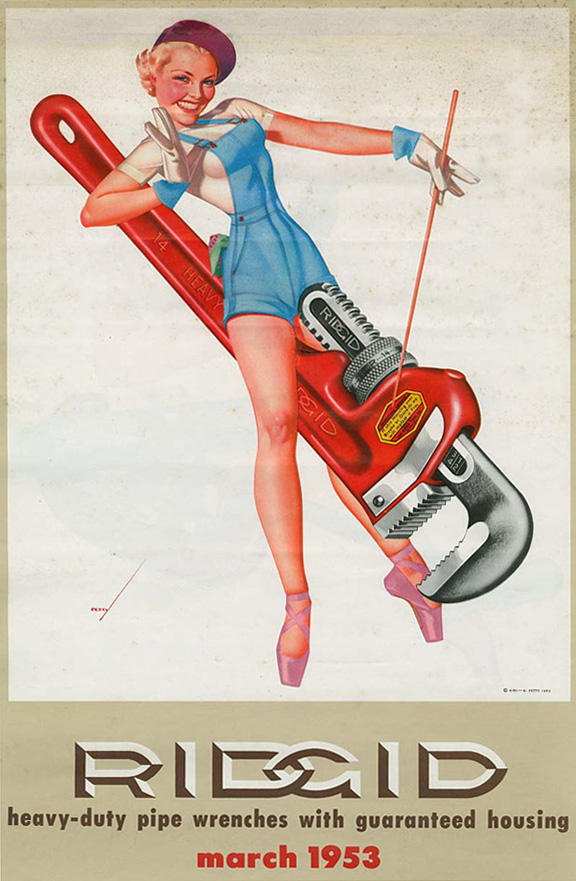
George Petty, illustration for Ridgid Tool Calendar, March 1953, this taken from the beautiful scans made available at The Reluctant Paladin (with whose kind permission this is shown here).
- Walker Evans.
- Lizzie Rockwell, illustrator of tools in two series,
Hardware Store Alphabet Cards (2005)
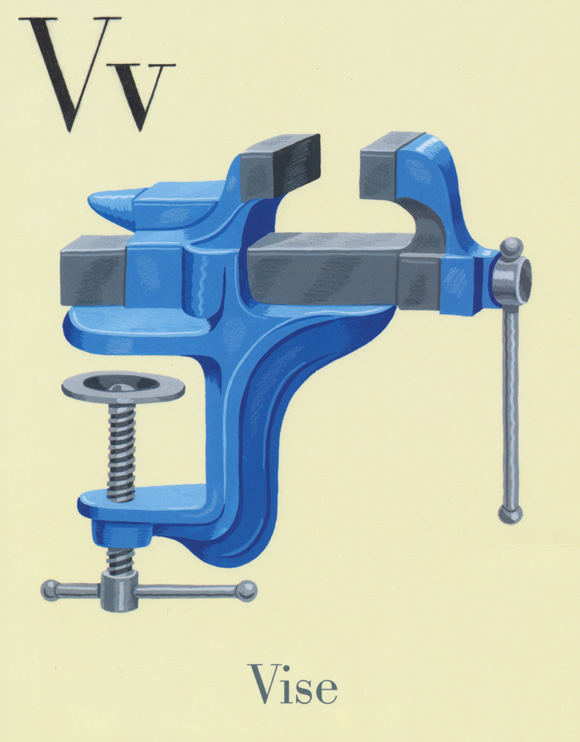
Detail (minus border), copyright Lizzy Rockwell; shown with permission of the artist.
and Hardware Store Lacing Cards (2008?).
Artist’s website here.

- Winston Rowntree (pseudonym), One home and one garden please, in
Later with the Sphinx,
at Subnormality
ca. December 2010.Shown with gracious permission of the artist.
More Subnormality; and something on the artist at about. Stumbled upon via a languagelog post and discussion of the ambiguity inherent in language (and specifically, names).

- Bill Russell. Scratchboard illustration to Stephen King, Needful Things. New York: Viking, 1991
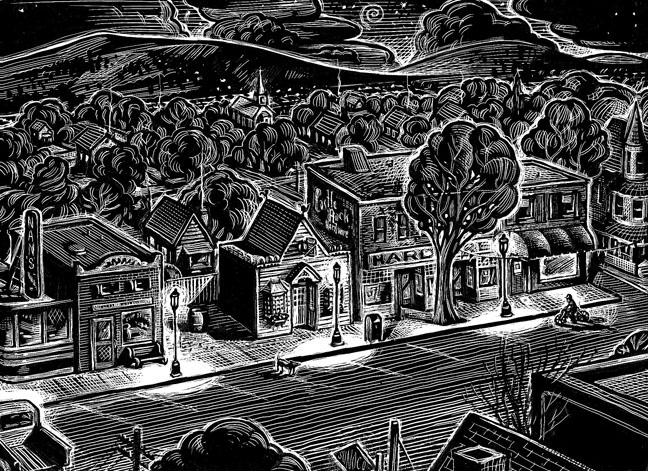
Shown with gracious permission of the artist.
More about the novel — and a scan of the illustration as it appeared as frontispiece — at the Hardware Store
Fiction
page, here. This and other of Bill Russell’s scratchboard illustrations can be seen at his illogator page, here. See also Russell’s billustration and Profile Reportage sites.
- J. P. Schmelzer. Pen and ink illustration of store interior for Marti Attoun,
The Nuts and Bolts of Gift Giving.
Ford Times 81:12 (December 1988): 18-19
credit : J. P. Schmelzer
Permission to show this illustration kindly given by the artist, who writes:
I like hardware stores myself, especially old ones with wooden floors. One of the best ones I have been in lately was one on Fulton Street, off lower Broadway in Manhattan of all places. It was about 10 feet wide, just wide enough to have some small stuff on each side as you went about 25 feet to the counter, and then everything else came from
the back
.Schmelzer refers to Fulton Supply & Hardware; his own website is here.

- Kateřina Šedá, It Doesn’t Matter
exhibit at The Renaissance Society at the University of Chicago, January 06 – February 10, 2008Katerina Seda got her grandmother (77) to draw every tool she could remember from the hardware store she worked at for over 30 years, as a way to stay engaged with friends and family. The gallery description follows :
“Czech artist Katerina Seda’s primary media are her friends, family, and community of her native town Lisen. Seda (b. 1977) uses performance, staged activities, and public interventions to reactivate social concourse as it is the basis for a sense of self predicated on group identification. The Society will present It Doesn’t Matter, a series of over 600 drawings executed by Seda’s 77-year-old grandmother, cataloging in size and type the various tools and supplies sold through the Brno hardware shop her grandmother managed for over thirty years under communism. While therapeutic in intent, the result is a profound reflection on memory and subjectivity as expressed through, rather than in spite of, alienation.”
Scroll down to image from
It Doesn't Matter
at theartblog (May 3, 2009), which clicks to a good enlargement. This critic finds the drawings oppressive, perhaps because of their tool/hardware subject matter?Kateřina Šedá, artist’s website : link
@katerinaseda.cz at instagram : link
at wikipedia : link
- Sarah Smith.
Clark Bros. Bolt Co.
Printer’s cuts — metal plates (in this case copper) mounted type-high on wood. 2011.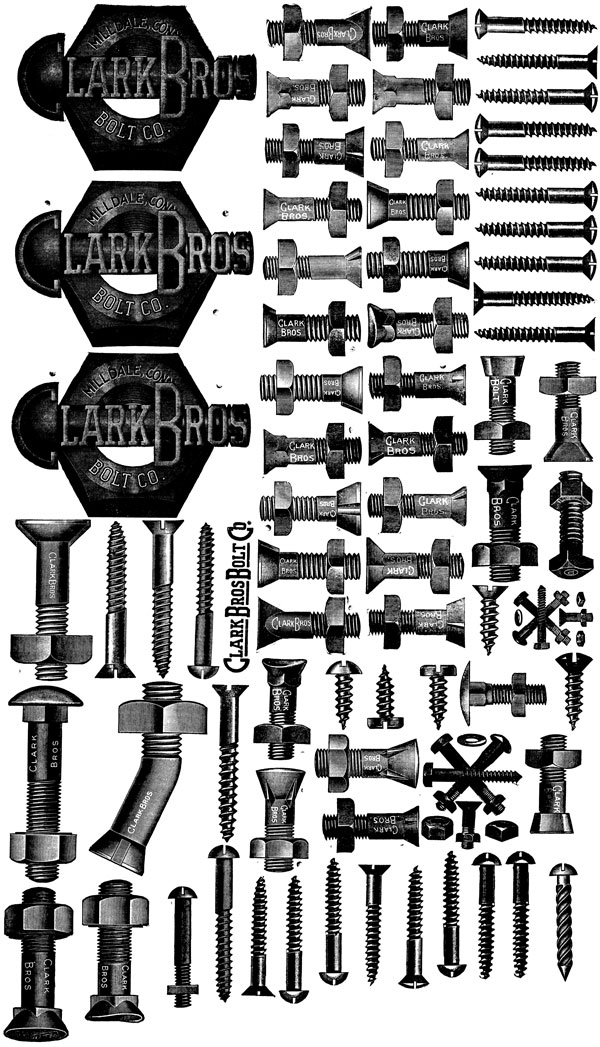
Image shows approximately 7.5 x 13.5 inches, cropped from sheet approximately 12 3/4 x 18 3/4 inches.
Courtesy of Sarah Smith,
olfactory gleanings : linkIG.Beautifully printed arrangement of cuts of bolts and screws, 6 of 18, 2011. Will attempt to identify some of the more obscure bolt shapes, including those with oddly shapped heads (boilers?), and the screw at bottom right.

- Jennifer Taylor, illustrator for Lisa Westberg Peters, Frankie Works the Night Shift (2010)
no links work, or Taylor’s own website requires flash. maintained here for reference.

- Tim Taylor.
Houghton Hardware Captured on Ornament by Dining Services Cook
in University of New Hampshire Campus Journal, 2 December 2009 here (dead link)Sure enough, the longtime business moved out of town a couple of years ago. In recent weeks, the building was demolished. But the memory of what was there will live on in this year’s Durham Business Association’s Christmas ornament, which bears an image of the hardware store painted by Taylor in 1998...

- Sherry Thurner. Ace Hardware (Janesville, Wisconsin).
12 x 12 inches, acrylic on canvas board
Shown here with kind permission of the artist, and more fully described in her interesting book- and painting-filled blog : sherry-latebloomer.blogspot.com (posted November 15, 2009).
Sherry Pierce Thurner (1950-2019)
“Janesville loses artist, teacher, historian, friend,” Frank Schultz, Gazettextra (March 21, 2019) : link
obituary Gazettextra : linkSomething about the lettering brings Ed Ruscha to mind — not so much his Ace (1962), but maybe something like See (1992)?

- William Tillyer. Hardware Variations on a Theme of Encounter
William Tillyer, Aluminium Cloud 2002
acrylic paint / aluminium D handle on MDF panel
15 x 18 x 3 3/4 inches
Shown with gracious permission of the artist.In this interesting body of work circa 2002-05, pieces of hardware (e.g., drawer pulls, pieces of wood) are deployed as
obstacles
in the surfaces and structures of the support, against which the paint is conceived as aprotest.
Much (all?) of this work was done in Ireland (Tillyer lives in England), and the essay that appears in the catalogue of Hardware Variations on a Theme of Encounter ( and here ) is in part a reflection on being there (leading to memories of other landscapes, e.g., Southern California’s deserts, as well). The essay is also a long meditation on ways that Tillyer finds to avoid paint’s being a
surrogate for some figuration or narrative,
withoutbeing an expressive mark or gesture.
(Of particular interest is an analytical diagram entitledPlan tracing the movement of painting through perspective, paint and construction.
) Hardware and pieces of wood are used in his strategy to move forward.A frontispiece photograph of
The American Hardware Store, Caherciveen
suggests Tillyer’s engagement with hardware, land and skyscapes on both sides of the Atlantic, but also with American luminist painters (including Frederick Church). That Caherciveen image — originally from a postcard — is shown among thepaeans and ubi sunts,
here.The artist’s website is beautiful and substantial: showing works but also providing his writing as well. Tillyer constantly changes his own game, working in watercolor, oil, acryic, working with wire mesh, screenprinting, etching. A monograph published in 2000, Norbert Lynton’s William Tillyer: Against the Grain, provides a critical overview.

- Calendar Art
Back around the pipe threading machine, one might have found the Ridgid tool calendars featuring swimsuit-clad models in suggestive poses with dies, reamers, pipe wrenches and other tools. Here’s one such, from May-June 1976. (searchridgid
andcalendar
on flickr to find more.)Before Ridgid went to photographs,
Cheesecake
illustrator George Petty made his mark in this specialty genre. Here, for example, is a flickr set of the 1953 calendar. Columnist Steve Duin of The Oregonian has blogged about this phenomenon here.
2 September 2013; 29 June 2023
